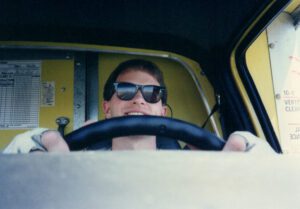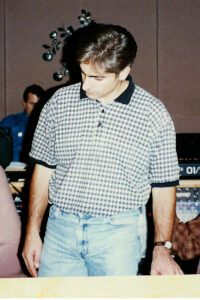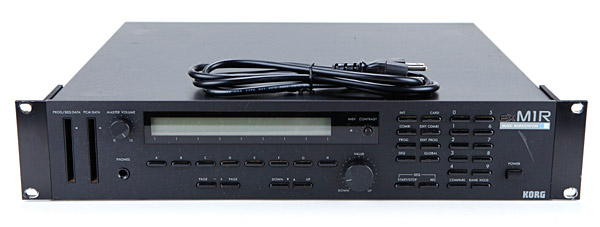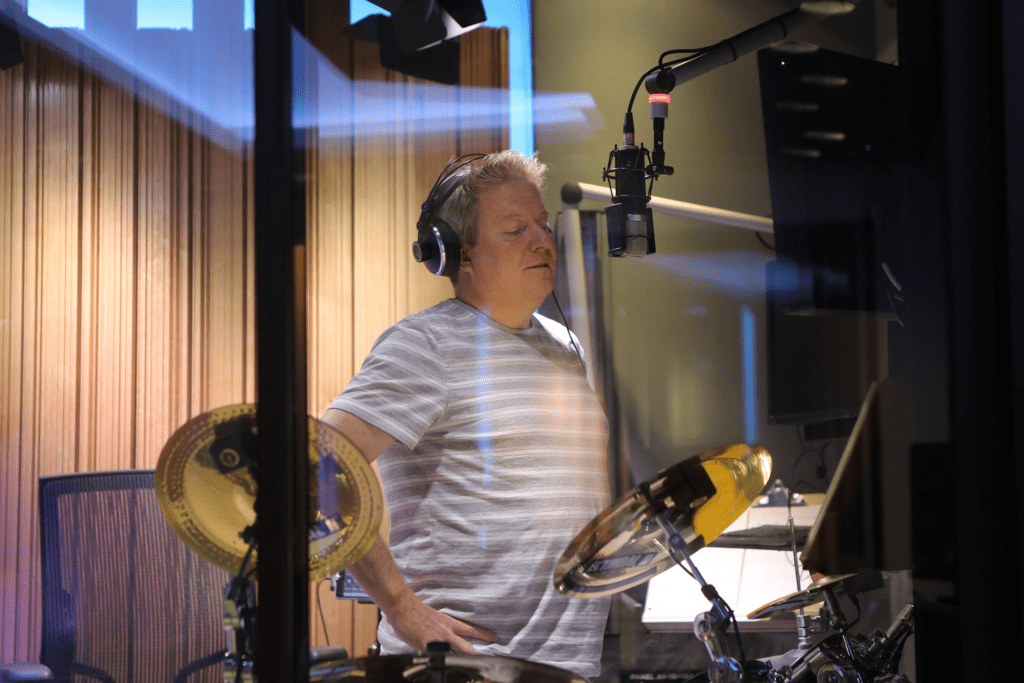My buddy Paul Sirvatka is coming back this week. We’ve got a huge project we’ve decided to take on. If we manage to pull it off, it will be more than two decades in the making.
[blockquote]This is Part 2 of a series on the production of A Time Will Come For Singing (Special Edition). See All Posts[/blockquote]
As I mentioned in the blog post back in March, Paul and I met back in 1988 when he, the 20-something director, and I, a 17 year old high school senior, performed together in the St. Petronille Contemporary Choir in Glen Ellyn, IL. When I graduated the following year and went to college, and later grad school, I only sang with the group when I was home from school. Still, it was always great to be back with them and I immensely enjoyed my time with the group.
It was a fairly regular occurrence in those days for people to come up to us after Mass and ask if we’d ever considered recording a CD. And indeed, we had done a few “semi-serious” recordings over the years, where the group would set up all our gear on the front steps of the church sanctuary, and then record some of our best stuff on a simple 2-track cassette that we could share with friends and family. These sessions were recorded by a St. Pet’s parishioner, Larry Pecorella, who worked at a professional studio in nearby Wheaton, IL.
But doing an actual album in those days was still a very expensive undertaking, even if the group happened to be friends with a guy like Larry. You were looking at several weeks of studio time, expensive 2-inch reel to reel tape, and, of course, all the costs that come with mastering and manufacturing a CD. So the group always talked about how “it would be fun to do a CD” but the conversation never really went any further.
In August of 1995, I had just left for California to start law school at USC.

Apparently, some time that Fall, back in the suburbs of Chicago, the “we should do a CD” conversation took a very abrupt turn. I don’t know the exact details, but it seems a group of parishioners at St. Petronille who really enjoyed the Contemporary Choir’s music approached Paul and offered to put up the funds to send the group to Larry Pecorella’s studio. It’s my understanding that there was a strong feeling that the group should jump on the opportunity and have an album out in time for Christmas — a little more than 2 1/2 months away.

With the choir’s longstanding dream of making an album finally having a green light, Paul and Larry quickly set about choosing the music the group would record. The range of music was ambitious — everything from classical a cappella to vocal jazz to straight-ahead rock. That, of course, presented a problem. The choir typically performed with Paul on keyboard, maybe one or two guitar players, and me on bass guitar, if I happened to be home from school and had my bass with me. On a shoestring budget, with no money to hire a bunch of extra musicians, where were they going to get the other instruments (particularly drums, strings, and bass guitar) from? Today, we would simply fill in all the missing pieces from any of a wealth of excellent, reasonably priced sample libraries you can buy over the internet. Those libraries are so good today that if I didn’t tell you they were sampled, you would have no idea that they weren’t performed live in the studio.
Granted, the idea of “fill in the missing pieces with canned versions coming out of a box” is not remotely new. Even by the late 70s, any synthesizer worth its salt was marketed as having the near-magical ability to mimic a wide variety of instruments across all sorts of different genres of music. Later, as memory and processing power got cheaper, synthesizers became polytimbral — using MIDI data provided from a sequencer, you could play back two or more instruments from one synth “brain” at the same time.
[blockquote]Doing an album on a shoestring budget in 1995 necessarily involved a lot of compromises, especially when your arrangements called for instruments that no one in your band could play. [/blockquote]
Paul owned a Korg M-1R sound module — the synthesizer “brain” of Korg’s popular M-1 keyboard — the highest selling synthesizer of all time, in a rackmount format. In live performances, he frequently used the M-1R to add an extra sheen to whatever he was playing on the digital piano. Using a MIDI connection between the module and the digital piano, he’d layer on an extra “pad” of ambient strings to give the piano a little more body and depth. Sometimes, he’d “split” the keyboard, to where the upper half might be the piano’s native sound, and the lower half might be an upright bass provided by the M-1R. In that way, Paul was able to provide two or more types of instruments from a single keyboard.

Paul’s brother, Jason, meanwhile, was an excellent musician in his own right. In addition to playing guitar and piano, Jason also had a real talent for assembling MIDI-driven backing tracks for the group. For special occasions like Christmas or Easter, Jason and Paul worked up a bunch of MIDI sequences that Paul could drive from his position at the keyboard. Paul might be playing keyboard, along with a guitar player or two, but we’d hear something approximating a full band coming out of the speakers: drums, bass guitar, strings, various percussion effects, and the occasional syncopated hand clap.
So the solution to filling in all the missing pieces for the group’s little album project — not very different from how we’d solve that problem today — was to create MIDI sequences to cover the parts they couldn’t play live. Jason and Paul sketched out parts for twelve different songs. In the studio with Larry, each of those parts were recorded to different tracks on the 24-track, 2-inch analog tape. That allowed those instruments to be mixed just like they’d been played live in the studio.
History, unfortunately, has not been kind to “low budget” recordings from that era. The performances may have been great — but to the contemporary ear the instruments used to render those performances — all drawn from a couple megabytes of memory on one box — sound thin, brittle and–well, canned. But I’ll talk more about that in a later post.
By December, the project was recorded, mixed, mastered, and sent off for duplication. As planned, copies were available for sale Just In Time For Holiday Gift-Giving®.
The album was named for its opening track, A Time Will Come For Singing, Dan Schutte’s wistful song of hope.

It speaks of a time “when all your tears are shed; when sorrow’s chains are broken, and broken hearts shall mend.” Paul mentioned many times over the years how they played it at his grandfather’s funeral, and how much the song meant to him. In the Catholic Church, the season of Advent–the four weeks leading up to Christmas Day–are an important time of waiting and expectation. So the song was a very nice way to set the tone for the coming of Christmas.
The album featured a number of Christmas standards such as “Veni, Veni Emanuel (O Come, O Come Emanuel)”, “Lo, How A Rose E’er Blooming” and “What Child Is This?”, along with some of the choir’s other favorite, lesser known tunes like “A Noble Flower of Judah” and “Song of God Among Us”. Paul also managed to sneak in an original track he’d written, “Here I Am, O Lord” — nominally a setting of Psalm 40. With new verses taken from the Magnificat, Mary’s song of joy after learning she will be the mother of Jesus, Paul adapted a non-Christmas song into something that felt like it fit alongside the other carols and holiday tunes on the album.
[blockquote]In the Catholic tradition, the season of Advent (the four weeks leading up to Christmas Day) is an important time of waiting and expectation. A Time Will Come For Singing is not just a Christmas album, but an Advent album.[/blockquote]
So that is what we were all listening to in the winter of 1995. The album was a huge hit around the parish, and the group quickly sold out their production run of 1000 CDs. Paul resigned as director not long thereafter, and while the St. Petronille Contemporary Choir continued as a group going forward, the group was really never the same after that. With the choir under new direction, after the album sold out, no new copies were ever made.
Over the years, though, the members of the choir, along with countless friends and family from St. Petronille who’d heard us perform over the years, treasured their well-worn copies of the CD as an important part of their Christmas celebrations. While the album was never made available online or otherwise available for sale, some of us never really forgot about the album. And now, more than 20 years later, a new project is stirring to bring this classic album into the 21st century.
I’ll have the next chapter of this story tomorrow.
Share this:
- Click to email a link to a friend (Opens in new window) Email
- Click to share on X (Opens in new window) X
- Click to share on Facebook (Opens in new window) Facebook
- Click to share on LinkedIn (Opens in new window) LinkedIn
- Click to share on Pinterest (Opens in new window) Pinterest
- Click to print (Opens in new window) Print


